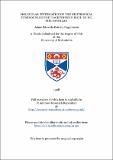Files in this item
Molecular systematics of the neotropical tuberous legume 'Pachyrhizus' Rich. ex DC, the yam bean
Item metadata
| dc.contributor.advisor | Abbott, Richard J. | |
| dc.contributor.author | Engelmann, Jaime Eduardo Estrella | |
| dc.coverage.spatial | 288 p. | en_US |
| dc.date.accessioned | 2018-06-15T15:04:51Z | |
| dc.date.available | 2018-06-15T15:04:51Z | |
| dc.date.issued | 1998 | |
| dc.identifier.uri | https://hdl.handle.net/10023/14132 | |
| dc.description.abstract | The Neotropical genus Pachyrhizus Rich, ex DC. (the yam beans) is one of the few legume genera with edible tuberous roots. Two of its five species (P. ahipa and P. tuberosus) are cultivated by rural communities in the Andean and Amazonian regions, while a third species (P. erosus) is grown on a large scale in Central America for the domestic and international market. Current breeding work in Costa Rica, Ecuador, Denmark, Portugal and Tonga is aimed at increasing the potential use of the genus as a crop. The objective of this research was to construct a phylogeny for the genus based on molecular variation, and to establish relationships and levels of genetic diversity among Pachyrhizus species. A phylogeny based on chloroplast (cp) DNA variation separated the genus into two evolutionary branches, i.e. a Mesoamerican and a South American branch, reflecting a consistent phylogeographic pattern of species distribution and dispersal. The wild species P. ferrugineus (resolved as the most primitive within the genus) together with wild and cultivated P. erosus represented the Mesoamerican branch. Materials of Andean and Amazonian distribution, namely P. panamensis, the P. tuberosus complex and the highly derived species P. ahipa made up the South American evolutionary branch of the genus. P. panamensis was the most primitive taxon in this group. A phylogeny constructed from sequence variation of the internal transcribed spacer (ITS) region of nuclear ribosomal DNA complemented the cpDNA phylogeny to a broad extent, separating Pachyrhizus species into similar clades and reflecting a congruent phylogeographical distribution. The ITS phylogeny also indicated that P. panamensis and wild taxa of P. tuberosus and P. erosus probably originated after rapid radiation from a continuously distributed early ancestor (i.e. ecotypes of P. ferrugineus). Subsequently, speciation may have accompanied divergent adaptation to dissimilar ecological niches in two directions: to areas with conspicuous annual dry seasons and deciduous forests in Mesoamerica, which in turn resulted in the origin and specialisation of P. erosus and its several primitive landraces and cultivars; and, to the tropical and subtropical rainforests and Andean valleys, giving rise to the different aided by domestication and man-made selection. Phenograms produced from RAPD variation were congruent to a broad extent with the phylogenies obtained from cpDNA and ITS variation, confirming the affinity between P. ahipa and P. tuberosus, and revealing the existence of three gene pools in Mesoamerica and Mexico. P. tuberosus appears to have played a significant role in the evolution of the genus. Multiple lines of molecular evidence suggest that this species might also be ancestral to P. erosus, as a separate lineage. Moreover, an early, wild ancestor of P. tuberosus was also closely related to other wild species (i.e. P. panamensis and P. ferrugineus); and, some of the cultigen types of the P. tuberosus complex encompass the early ancestry of the highly advanced species P. ahipa. Finally, a broad range of potentially exploitable genetic diversity was identified in this study, enabling both the implementation (or continuation) of in situ/ex situ conservation strategies, and a more efficient progress towards genetic breeding of yam beans. | en_US |
| dc.language.iso | en | en_US |
| dc.publisher | University of St Andrews | |
| dc.subject.lcc | QK495.D54E6 | en |
| dc.subject.lcsh | Dioscoreaceae | en |
| dc.title | Molecular systematics of the neotropical tuberous legume 'Pachyrhizus' Rich. ex DC, the yam bean | en_US |
| dc.type | Thesis | en_US |
| dc.contributor.sponsor | Sir Harold Mitchell Fund | en_US |
| dc.contributor.sponsor | Overseas Research Students Awards Scheme (ORSAS) | en_US |
| dc.type.qualificationlevel | Doctoral | en_US |
| dc.type.qualificationname | PhD Doctor of Philosophy | en_US |
| dc.publisher.institution | The University of St Andrews | en_US |
This item appears in the following Collection(s)
Items in the St Andrews Research Repository are protected by copyright, with all rights reserved, unless otherwise indicated.

